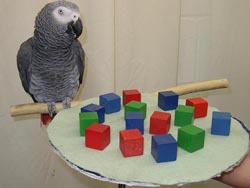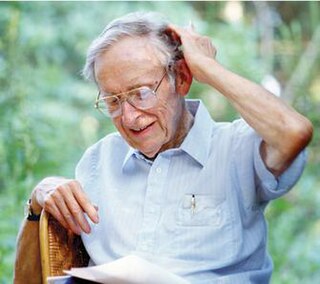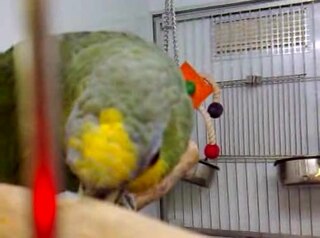A tongue twister is a phrase that is designed to be difficult to articulate properly, and can be used as a type of spoken word game. Additionally, they can be used as exercises to improve pronunciation and fluency. Some tongue twisters produce results that are humorous when they are mispronounced, while others simply rely on the confusion and mistakes of the speaker for their amusement value.

Hanabiko "Koko" was a female western lowland gorilla. Koko was born in San Francisco Zoo, and lived most of her life at The Gorilla Foundation's preserve in the Santa Cruz Mountains. The name "Hanabiko" (花火子), lit. 'fireworks child', is of Japanese origin and is a reference to her date of birth, the Fourth of July. Koko gained public attention upon a report of her having adopted a kitten as a pet and naming him "All Ball", which the public perceived as her ability to rhyme.

Psittacus is a genus of African grey parrots in the subfamily Psittacinae. It contains two species: the grey parrot and the Timneh parrot.
Irene Maxine Pepperberg is an American scientist noted for her studies in animal cognition, particularly in relation to parrots. She has been a professor, researcher and/or lecturer at multiple universities, and she is currently an Adjunct Research Professor at Boston University. Pepperberg also serves on the Advisory Council of METI. She is well known for her comparative studies into the cognitive fundamentals of language and communication, and she was one of the first to work on language learning in animals other than primate species, by extension to a bird species. Pepperberg is also active in wildlife conservation, especially in relation to parrots.

The cockatiel, also known as the weero/weiro or quarrion, is a medium-sized parrot that is a member of its own branch of the cockatoo family endemic to Australia. They are prized as household pets and companion parrots throughout the world and are relatively easy to breed compared to other parrots. As a caged bird, cockatiels are second in popularity only to the budgerigar.

Animal languages are forms of non-human animal communication that show similarities to human language. Animals communicate through a variety of signs, such as sounds and movements. Signing among animals may be considered a form of language if the inventory of signs is large enough. The signs are relatively arbitrary, and the animals seem to produce them with a degree of volition. In experimental tests, animal communication may also be evidenced through the use of lexigrams by chimpanzees and bonobos.

Alex was a grey parrot and the subject of a thirty-year experiment by animal psychologist Irene Pepperberg, initially at the University of Arizona and later at Harvard University and Brandeis University. When Alex was about one year old, Pepperberg bought him at a pet shop. In her book "Alex & Me", Pepperberg describes her unique relationship with Alex and how Alex helped her understand animal minds. Alex was an acronym for avian language experiment, or avian learning experiment. He was named the "Einstein of parrots" and at two years old was correctly answering questions made for six-year-old humans.

Eugene Pleasants Odum was an American biologist at the University of Georgia known for his pioneering work on ecosystem ecology. He and his brother Howard T. Odum wrote the popular ecology textbook, Fundamentals of Ecology (1953). The Odum School of Ecology is named in his honor.

Speech is a human vocal communication using language. Each language uses phonetic combinations of vowel and consonant sounds that form the sound of its words, and using those words in their semantic character as words in the lexicon of a language according to the syntactic constraints that govern lexical words' function in a sentence. In speaking, speakers perform many different intentional speech acts, e.g., informing, declaring, asking, persuading, directing, and can use enunciation, intonation, degrees of loudness, tempo, and other non-representational or paralinguistic aspects of vocalization to convey meaning. In their speech, speakers also unintentionally communicate many aspects of their social position such as sex, age, place of origin, physical states, psychological states, physico-psychological states, education or experience, and the like.

The difficulty of defining or measuring intelligence in non-human animals makes the subject difficult to study scientifically in birds. In general, birds have relatively large brains compared to their head size. Furthermore, bird brains have two-to-four times the neuron packing density of mammal brains, for higher overall efficiency. The visual and auditory senses are well developed in most species, though the tactile and olfactory senses are well realized only in a few groups. Birds communicate using visual signals as well as through the use of calls and song. The testing of intelligence in birds is therefore usually based on studying responses to sensory stimuli.

Sarah Grey Thomason is an American scholar of linguistics, Bernard Bloch distinguished professor emerita at the University of Michigan. She is best known for her work on language contact, historical linguistics, pidgins and creoles, Slavic Linguistics, Native American languages and typological universals. She also has an interest in debunking linguistic pseudoscience, and has collaborated with publications such as the Skeptical Inquirer, The Encyclopedia of the Paranormal and American Speech, in regard to claims of xenoglossy.

Talking birds are birds that can mimic the speech of humans. There is debate within the scientific community over whether some talking parrots also have some cognitive understanding of the language. Birds have varying degrees of talking ability: some, like the corvids, are able to mimic only a few words and phrases, while some budgerigars have been observed to have a vocabulary of almost 2,000 words. The common hill myna, a common pet, is well known for its talking ability and its relative, the common starling, is also adept at mimicry. Wild cockatoos in Australia have been reported to have learned human speech by cultural transmission from ex-captive birds that have integrated into the flock.
In phonetics, ingressive sounds are sounds by which the airstream flows inward through the mouth or nose. The three types of ingressive sounds are lingual ingressive or velaric ingressive, glottalic ingressive, and pulmonic ingressive.
A talking animal or speaking animal is any non-human animal that can produce sounds or gestures resembling those of a human language. Several species or groups of animals have developed forms of communication which superficially resemble verbal language, however, these usually are not considered a language because they lack one or more of the defining characteristics, e.g. grammar, syntax, recursion, and displacement. Researchers have been successful in teaching some animals to make gestures similar to sign language, although whether this should be considered a language has been disputed.

Parrots (Psittaciformes), also known as psittacines, are birds with a strong curved beak, upright stance, and clawed feet. They are conformed by four families that contain roughly 410 species in 101 genera, found mostly in tropical and subtropical regions. The four families are the Psittaculidae, Psittacidae, Cacatuoidea (cockatoos), and Strigopidae. One-third of all parrot species are threatened by extinction, with a higher aggregate extinction risk than any other comparable bird group. Parrots have a generally pantropical distribution with several species inhabiting temperate regions as well. The greatest diversity of parrots is in South America and Australasia.

An omnivore is an animal that has the ability to eat and survive on both plant and animal matter. Obtaining energy and nutrients from plant and animal matter, omnivores digest carbohydrates, protein, fat, and fiber, and metabolize the nutrients and energy of the sources absorbed. Often, they have the ability to incorporate food sources such as algae, fungi, and bacteria into their diet.

The Timneh parrot, also known as the Timneh grey parrot or Timneh African grey parrot, is a West African parrot. Formerly classified as a subspecies of the grey parrot Psittacus erithacus timneh, it is now considered a full species Psittacus timneh. In aviculture, it is often referred to by the initials TAG and is commonly kept as a companion parrot.

The grey parrot, also known as the Congo grey parrot, Congo African grey parrot or African grey parrot, is an Old World parrot in the family Psittacidae. The Timneh parrot (Psittacus timneh) once was identified as a subspecies of the grey parrot, but has since been elevated to a full species.

Apollo is an African grey parrot and the subject of the popular YouTube channel "Apollo and Frens" run by Victoria (Tori) Lacey and Dalton Mason. Apollo has been described as having the intelligence of a "human toddler" and can answer numerous complex questions in English.













